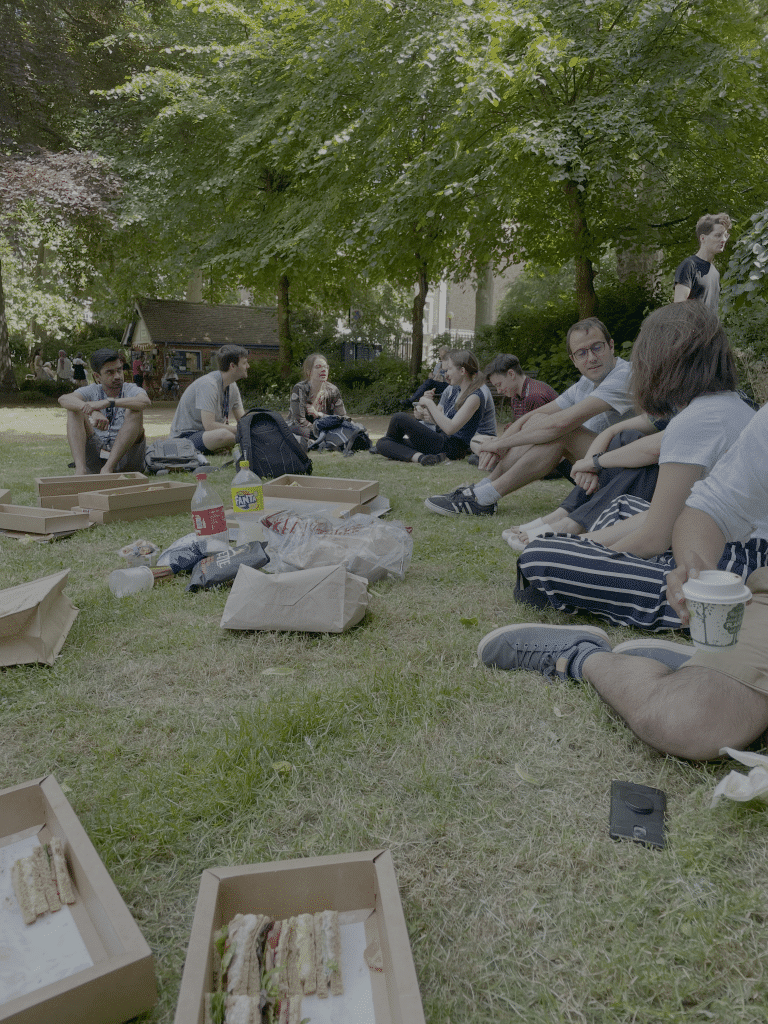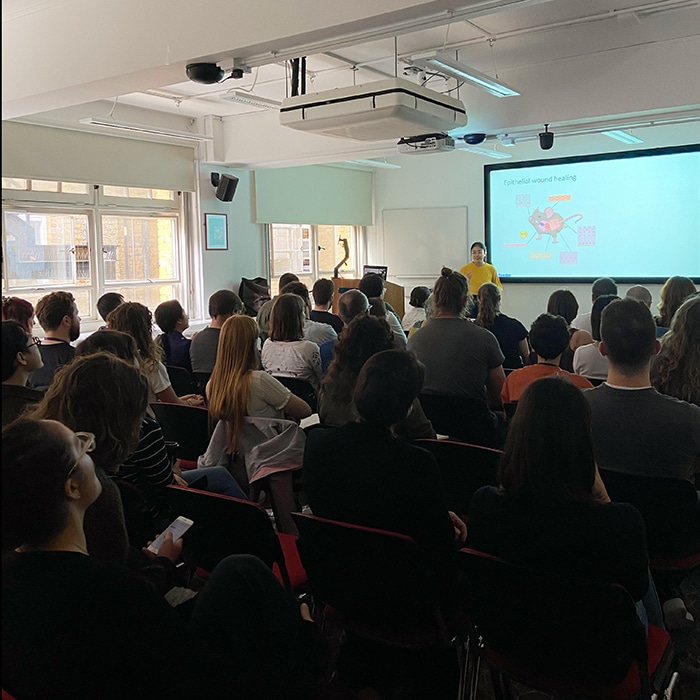Connecting Researchers Through Bioimaging: Reflections from UCL’s BioImage Interest Group
Posted by Courtney Lancaster, on 11 August 2025
Bioimaging: A bridge across scales and disciplines
Bioimaging has become a cornerstone in modern biological research, allowing scientists to visualise the intricate structures of cells and organisms. It also allows us to bridge biological scales — from whole organisms down to molecules. Beyond its beautiful images, bioimaging provides crucial quantitative insights into a whole host of biological questions.
Over the past two decades, there has been a rapid advancement in software and hardware associated with bioimaging. This has expanded the scope of bioimaging and the types of information we can access about biology. Imaging papers are no longer illustrative with qualitative analysis; they now aim to provide quantitative analysis with more comprehensive descriptions of the biology in question. This highlights the shifts within scientific publishing and the impact imaging can have on discovery. Bioimaging advancements have also introduced new challenges: How do we interpret complex imaging data? How do we select the right imaging techniques? How can researchers across disciplines collaborate productively? How do we instil best practices in bioimaging and analysis? These questions inspired the formation of the BioImage Interest Group (BIIG) at University College London (UCL).
BIIG was founded in 2020 in the wake of the COVID pandemic by a postdoctoral researcher and a research software engineer. It acts as a forum for researchers, especially early-career researchers and technical staff, to discuss the technical aspects of bioimaging and image analysis and to build an interdisciplinary community of bioimaging enthusiasts.
This article is a reflection from a Bioimage Interest Group where we highlight the value of a bioimaging community for scientific research.
Building a bioimaging community
BIIG was established to bring together researchers from different disciplines and institutes at UCL and beyond. Our mission is to facilitate communication between researchers who have different backgrounds and expertise in bioimaging. To function as a cross-disciplinary forum, the organising committee is diverse in its background. The committee comprises PhD students, postdoctoral researchers in both biology and computer science, microscopy technicians, and research software engineers. This diverse committee aims to create a wide base of interests from which we can invite speakers and organise events. It also creates a friendly space for transparent discussion about different techniques, imaging modalities, and projects.

Hack day participants enjoying a well-earned picnic
The importance of creating a bioimaging discussion space
- Encouraging multidisciplinary communication
Bioimaging is multidisciplinary, incorporating biology, physics, chemistry, engineering, and computer science. However, researchers tend to stay within their own communities due to convenience and time constraints. Moreover, communicating across different fields has its own challenges which can form artificial barriers between researchers. We think it is important to communicate across fields to enrich our questions and research interests and to have fun in the process. BIIG creates a bridge between different researchers, hopefully making interdisciplinary communication more productive and easily accessible in one room.
- Optimising access to imaging resources
UCL hosts the latest cutting-edge microscopes, yet researchers may not be aware of the most suitable systems for their experiments. Often, we do not know it, but we have the ideal system for us across the road in another research institute. BIIG helps researchers to navigate imaging resources by creating a forum to share experiences of different microscopes and the types of data that can be collected. It also increases the likelihood that we are using the correct systems suited for our questions, hopefully with less trial and error.
- Making image analysis accessible
Many biologists lack formal training in coding and programming, yet it is becoming common to require more sophisticated image analysis pipelines. This is largely due to being able to collect more data, across larger scales and at a faster rate. We are great at generating data but what use is this data if we cannot interpret and identify patterns in it? This is where collaboration between biologists and computer scientists is invaluable. BIIG aims to provide education about programming and image analysis with an emphasis on best practices in these fields. It also enables collaboration between biologists and software engineers. Ultimately, this could lead to the development of accessible image analysis tools which can be used by the wider biological community.
- Improving career opportunities for early career researchers
A dedicated bioimaging community enables targeted networking across institutes and disciplines. These connections can lead to new collaborations that strengthen an early career researcher’s academic profile and open doors to new funding and project opportunities. Additionally, being part of such a network increases visibility and access to job openings, helping researchers shape and advance their career paths.
BIIG in action
- Monthly seminars
BIIG’s main initiative is a hybrid (online/in-person) monthly seminar where we discuss microscope systems, data analysis, and emerging bioimaging technologies. The seminars are followed by lunch where the discussion can continue in more depth to spark new ideas and collaboration. Each seminar features two speakers in a semi-informal format to encourage open discussion. Our talks focus on early-career researchers (30% non-traditional academics, 30% PhD students, 40% postdocs across 13 different UCL departments) and encourage troubleshooting presentations. The sessions are organised to display a wide range of imaging systems for different biological scales and information. The sessions not only introduce the participants to new microscopes, but they connect them with users who can provide guidance on specific imaging challenges. The talks have also put the microscopes on the map, so we know where to find them and how to access them.
Another central focus of our seminars is image analysis, which helps the community to make sense of imaging data. We have hosted seminars on 3D segmentation, AI-powered image analysis, real-time image analysis on the microscope for tracking moving samples, and using ImageJ macros and Python. These seminars provide an excellent opportunity for attendees—including PhD students, postdocs, computer scientists, and technicians—to share feedback, exchange ideas, and collaboratively improve image analysis pipelines.
- Image analysis workshop/hack day
BIIG has been hosting an annual Image Analysis Hack Day to help researchers tackle real-world problems in image analysis. On day one we host hands-on tutorials in python and software engineering. The training day is followed by a problem-solving hackathon, where participants organise into teams to work on an image analysis problem. The exciting aspect of this is that we are helping participants solve their problems in a fun and collaborative environment. The hack day ends with a social event which is a relaxed environment where we can chat with fellow colleagues and students at UCL over food and drinks.

BIIG monthly seminars in action
Impact: Strengthening the research community
- Enabling interdisciplinary grants
A key aim of BIIG is to foster a multidisciplinary forum for bioimaging and image analysis. Beyond building a community, we hope to enable meaningful collaborations that drive research forward. One notable success has been connecting biologists with software engineers, resulting in a successful grant application for updating image analysis software. By bringing together different experts, this collaboration produced an accessible tool for the broader research community. The software was packaged into a user-friendly graphical user interface, enabling biologists without advanced coding skills to access the software to analyse their own data.
- Enhancing training and education
BIIG has also contributed to education and mentorship. One collaboration has led to the co-supervision of a Master’s project that combines tissue imaging with computational analysis. This joint project exposes the student to biology and programming principles with the output being a better understanding of a biological process.
- Promoting open science
BIIG encourages the development and use of open-source software so that bioimaging tools are accessible to a wide audience. We encourage that data is Findable, Accessible, Interoperable, and Reusable which is under the FAIR principles for data management. As mentioned above, we encourage the development of programming skills, but we also expose researchers to user-friendly software. This creates a community where there are reduced barriers to imaging and image analysis.
Challenges of running a Bioimage Interest Group
Being part of the organising committee for a BioImage Interest Group has been extremely rewarding and as a committee we are proud of the friendly and open atmosphere we have created. It is great to see researchers from different career stages and departments interact. Many of us have met researchers through BIIG whom we might not have otherwise encountered, despite how close we are geographically. We often bump into each other at conferences where discussion and collaboration can continue outside UCL.
However, there are some challenges of running such an interest group, but the benefits far outweigh these challenges!
- Securing ongoing funding to sustain our events, particularly providing lunch after seminars, which is one of the major networking opportunities
- The transient nature of the academic environment means there is a high turnover of participants as they move into new positions. As a result, it is important that we continually promote the group to engage new members and to keep the group evolving.
- Finding a diverse range of speakers each month also requires continued effort. Having a diverse committee, spanning different departments, is instrumental in making sure we have a great line-up of speakers each month
Looking ahead: The future of BIIG
BIIG has demonstrated the value of having a dedicated bioimaging community and we hope it will continue to expand. Looking ahead, we plan to organise a formal bioimage analysis training course, enabling more researchers to gain the skills to analyse imaging data. We also think this type of training in computational skills will equip researchers for their next roles, inside or outside academia. Additionally, we aim to strengthen our links with other London universities, as well as regional, national, and international community initiatives such as EuroBioimaging and GIoBIAS. By broadening our network, we can encourage more collaboration and the exchange of knowledge across institutions.
Website: https://www.ucl.ac.uk/lmcb/ucl-biig
Bluesky social: @biig-ucl.bsky.social
Email: bioimage-organisers@live.ucl.ac.uk
LinkedIn: https://www.linkedin.com/groups/14718624/
Funding: eScience Domain, Research Culture Seed Fund, ARC community funding, FLS faculty fund
Founders: Giulia Paci, Alessandro Felder
Organising Committee: Alessandro Felder, Virginia Silio, Kimberly Meechan, Tchern Lenn, Courtney Lancaster, Zimeng Wu, Shu En Lim, Nikoloz Sirmpilatze, Jonas Hartmann, Giulia Paci, Franck Pichaud (academic lead)



 (3 votes, average: 1.00 out of 1)
(3 votes, average: 1.00 out of 1)